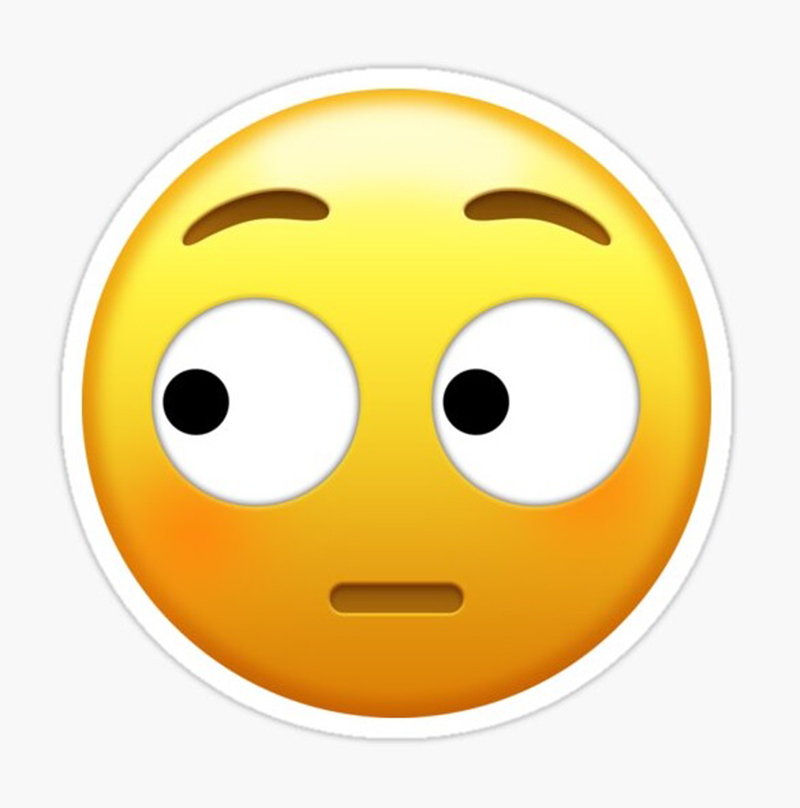One such emoji that can be subject to different interpretations is the side eye emoji. It’s one of the most popular emojis used today, but what does it really mean? In this article with Impeccable Nest, we’ll dive deep into the side eye emoji meaning, its nuances, and how you can use it effectively.

What is the Side Eye Emoji?
The side-eye emoji is a yellow face with one raised eyebrow and one eye looking to the side. It was first introduced in 2010 under Unicode 6.0 as part of the standard set of emojis available on smartphones and other devices. Since then, it has grown in popularity and has become a staple in many conversations.
The Side Eye Emoji Meaning
The side-eye emoji is used to convey a range of emotions, from skepticism to suspicion to disapproval. Here are a few possible interpretations of the side-eye emoji:
Suspicion
The side-eye emoji, also known as the “skeptical” or “distrustful” face, is an emoticon that conveys a sense of suspicion or disbelief. It is typically depicted as a face with narrowed eyes, one eyebrow raised, and a slightly turned-up mouth. The emoji is often used in response to something that someone has said that seems questionable or hard to believe.
When you use the side-eye emoji, you are essentially communicating that you are skeptical of what someone has just said. You may not necessarily be accusing the person of lying, but you are indicating that you are not entirely convinced or that you have your doubts. This can be used in a variety of situations, such as when someone makes a claim that seems too good to be true, or when someone says something that contradicts what you know to be true.
The side-eye emoji can also be used in a more playful or sarcastic way. For example, if someone makes a joke that falls flat or says something that is meant to be funny but isn’t, you might respond with a side-eye emoji to indicate that you find their attempts at humor less than impressive. Similarly, if someone makes a mistake or does something foolish, you might use the side-eye emoji to express your disapproval or condescension.
Disapproval
The meaning behind the side-eye emoji can be interpreted in a few different ways depending on the context in which it is used. However, in most cases, it is used to express a sense of suspicion, skepticism, or disapproval towards what someone has said or done. It is a subtle way of expressing dissatisfaction without resorting to outright confrontation or verbal communication.
One common scenario where the side-eye emoji might be utilized is during a group chat or social media conversation where someone shares a controversial opinion or piece of news. If you disagree with what they have shared but do not want to get into a heated argument, you might use the side-eye emoji to show that you are not fully on board with their viewpoint.
Additionally, the side-eye emoji can also be used in situations where someone says or does something that is inappropriate or offensive. Rather than engaging with them directly, using the side-eye emoji can convey your disapproval without explicitly stating why you disagree with their actions.
Judgment
The side-eye emoji, also known as the side-glance or the sideways glance emoji, is a popular facial expression used to convey a variety of emotions and attitudes. This emoji is represented by a face looking to one side with its eyes shifted, as if to express disbelief or suspicion.
One of the most common meanings behind the side-eye emoji is that it’s used to convey a sense of judgement towards someone or something. When you send this emoji, you may be using it to imply that the person or thing being discussed is not good enough or is not up to your standards. However, this expression can also be used in a playful or teasing way, where you are not actually trying to criticize or offend the other person.
For instance, you might use the side-eye emoji when your friend shows you a photo of their new haircut, but you don’t really like it. Instead of saying anything directly negative, you can send the side-eye emoji to subtly indicate your disapproval. Similarly, if someone tells you an unbelievable story, you might use the side-eye emoji to suggest that you’re skeptical of their claims.
However, it’s important to remember that the side-eye emoji can also be interpreted differently depending on the context and the tone of the conversation. Depending on the situation, the same emoji can be seen as either humorous or insulting. Therefore, it’s always a good idea to consider how your message might be perceived before sending it.
Skepticism
The side-eye emoji, also known as the “skeptical emoji,” is a popular symbol in digital communication that conveys a sense of suspicion and disbelief. It is depicted as a face looking sideways with raised eyebrows and an exaggerated glare, giving off an air of skepticism and doubt. This emoji has become increasingly common in online conversations, particularly when discussing controversial or unbelievable topics.
When someone uses the side-eye emoji, they are typically expressing their skepticism or doubt regarding a claim or statement made by someone else. For example, if a friend claims to have won the lottery, but their story seems suspicious, another person might respond with the side-eye emoji to indicate that they are not entirely convinced of the friend’s story. Alternatively, if a news article reports an outrageous event, such as a cat running for political office, someone may use the side-eye emoji to express their disbelief or amusement at the absurdity of the situation.
The side-eye emoji can be used in various contexts, including personal communication, social media posts, and even in professional settings. In some cases, it can be used humorously, such as when a friend tells a joke that falls flat or makes a ridiculous claim. On the other hand, it can also be used seriously, such as in situations where someone is presenting false information or making unsupported claims.
Irony
In some cases, however, the side-eye emoji is used in an ironic or sarcastic way to indicate that something is so obvious or ridiculous that it doesn’t even deserve a direct response. For example, if someone makes a statement that is completely untrue or absurd, another person might respond with the side-eye emoji instead of engaging in an argument or trying to refute the claim.
This usage can be particularly effective in online discussions, where arguments and debates can quickly become heated and unproductive. Rather than getting into a back-and-forth exchange with someone who is being intentionally difficult or unreasonable, the side-eye emoji allows the responder to express their disbelief or disapproval in a more subtle and indirect way.
Of course, like any other form of communication, the meaning of the side-eye emoji can vary depending on context and the relationship between the people involved. In some cases, it might be interpreted as playful teasing or friendly banter, while in others it could be seen as passive-aggressive or rude.
When Is the Side Eye Emoji Used?
The side eye emoji features a face with eyes looking sideways. This body language often indicates displeasure, skepticism, or feeling judgmental. Some common meanings and uses of the side eye emoji include:
- Showing irritation, annoyance, or being fed up with something or someone
- Expressing skepticism or doubt about something someone said or did
- Reacting to something cringeworthy, embarrassing, lame, or basic
- Virtually “giving attitude” in response to something you disapprove of
- Signaling boredom, disinterest, or feeling unimpressed
- Passive aggressively calling out inappropriate behavior
- Suggesting someone is being shady, fake, or phony
So in summary, the side eye emoji is used to throw virtual “shade” and signal varying degrees of disapproval or judgment.
Examples of Using the Side Eye Emoji
To better understand how the side-eye emoji can be used, here are a few examples:
- When your friend says they’ll pay you back “soon” but you’ve heard that before:
- Friend: “I promise I’ll pay you back soon”
- You: 🙄
- When someone suggests a questionable idea:
- Person: “Why don’t we just rob a bank?”
- You: 🤔
- When someone makes a corny joke:
- Person: “Why did the tomato turn red? Because it saw the salad dressing!”
- You: 😒
Comparisons with Other Emojis
The side-eye emoji is often compared to other facial expressions, such as the eye-roll or the raised eyebrow. While these emojis can convey similar emotions, each has its own specific meaning. The eye-roll, for example, is often used to indicate annoyance or exasperation, while the raised eyebrow can convey surprise or skepticism without the hint of disapproval that comes with the side-eye.
Frequently Asked Questions
What does the side-eye emoji mean in slang?
The side-eye emoji is often used in slang to convey suspicion or doubt. It can also be used as a playful way to tease someone.
Can the side-eye emoji be offensive?
Like any form of communication, the side-eye emoji can be offensive depending on the context and how it’s used. It’s important to be mindful of your audience and to avoid using the emoji in a way that could be perceived as hostile or negative.
Is the side-eye emoji gender-specific?
No, the side-eye emoji is not gender-specific. It can be used by people of any gender.
Can the side-eye emoji be used in professional settings?
While emojis are generally more casual than formal language, the side-eye emoji can still be used in professional settings as long as it’s used appropriately and in the right context.
What other emojis pair well with the side-eye emoji?
Emojis such as the eye-roll, the facepalm, and the crossed arms can pair well with the side-eye emoji to convey similar emotions or tones.
Conclusion
The side-eye emoji is a popular but nuanced emoji that can convey a range of emotions, from skepticism to judgment to disapproval. Using it effectively requires intentionality, context, and an understanding of its potential impact on the people you’re communicating with. By keeping these factors in mind, you can use the side-eye emoji to add personality and tone to your messages while avoiding misunderstandings or offense.In conclusion, the side-eye emoji has become a staple in digital communication, allowing us to convey complex emotions and tones with just a single character. While its meaning can be subject to interpretation, understanding its different nuances and tips for usage can help you effectively communicate your intended message. Remember to use it deliberately and sparingly, consider the context and audience, and always be mindful of how it may be perceived. With these considerations in mind, you can add personality and humor to your conversations while avoiding misunderstandings or offense.
Read more:
- What Does the Blue Eye Emoji Mean? – Get an Informative Guide to Unlock its Meaning!
- What Does the Big Eye Emoji Mean? Exploring Its Different Meanings and Uses

I am Lois Mullins, an enthusiast in emoji deciphering. Over the recent years, I have continuously updated and delved deep into the knowledge of emoji decryption.
I take pride in my extensive knowledge of decoding emojis, particularly in the Emoji Meanings of Impeccable Nest . I believe that a profound understanding of decoding these symbols can be beneficial for individuals in comprehending the nuances of language when someone sends them an emoji.
By grasping the nuances and potential misinterpretations of these emotional symbols, I am confident that people can use them more effectively to express their emotions and build stronger connections with others. I am committed to sharing my knowledge with the community so that everyone can harness the power of emojis in their everyday communication.
If you are seeking an experienced individual ready to share their passion for emoji deciphering, I hope for the opportunity to collaborate and learn from others. Together, we can create innovative and unique communication experiences!
